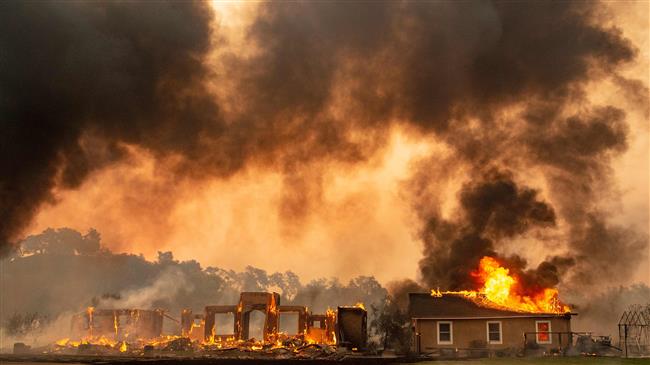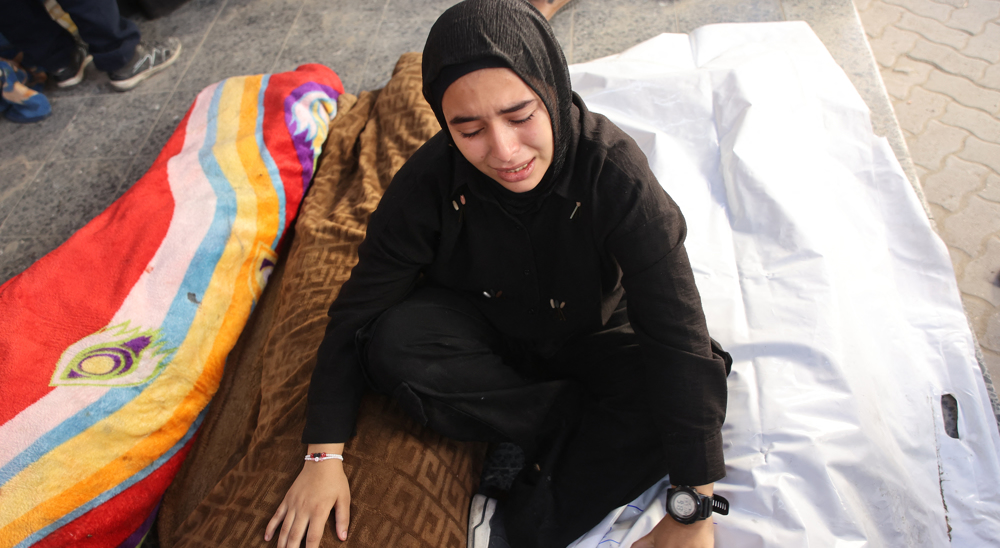Powerful winds further spread 'historic' California blaze
Powerful winds fanned Calfornia's biggest wildfire Sunday, threatening the city of Santa Rosa and forcing the evacuation of tens of thousands of people.
The Kincade Fire, north of San Francisco, spread to 30,000 acres (12,000 hectares); only 10 percent of it has been contained, state fire authorities said.
An estimated 180,000 people were under mandatory evacuation orders, including parts of Santa Rosa and a large swath of Sonoma County to the Pacific Ocean.
"This is the largest evacuation that any of us at the Sheriff's Office can remember. Take care of each other," the Sonoma County sheriff's office tweeted.
Gusts of 80 miles per hour (130 kph) were fanning the Kincade blaze -- which threatens tens of thousands of structures -- causing it to burn with greater intensity in remote steep terrain north of San Francisco, the National Weather Service (NWS) said.
A total of 77 structures, including 31 residential buildings, had been destroyed by the blaze as of Saturday, as more than 2,800 personnel were called to the scene, according to Jonathan Cox, spokesman for the California Department of Forestry and Fire Protection.
"Potentially historic fire weather conditions are possible" north of San Francisco, the NWS wrote in a tweet.

"This is definitely an event that we're calling historic and extreme," David King, a meteorologist with the service, told the Los Angeles Times.
"What's making this event really substantial ... is the amount of time that these winds are going to remain."
The gusting winds, which have caused a red-flag warning indicating high risk, will last into early Monday, meteorologists said.
California's largest utility, Pacific Gas & Electric Co., said it expected to turn off power to 940,000 homes and businesses -- a precautionary shutdown that local media reported would affect about two million people.
A map linked to by PG&E showed blackouts affecting large areas stretching some 250 miles to the north of San Francisco Sunday, as well as to the south and east.
The company said it "will need to turn off power for safety several hours before the potentially damaging winds arrive."

"Winds of this magnitude pose a higher risk of damage and sparks on the electric system and rapid wildfire spread."
'Don't know what to do'
"I can't explain it," 70-year-old Tina Tavares, who was evacuated from her Geyserville home, told the San Francisco Chronicle.
"It's like you're in a bad earthquake, the ground is opening up... and you're seeing it and don't know what to do."
PG&E has come under fierce scrutiny after power was earlier shut down to nearly 28,000 customers in Sonoma County this week, but some high-voltage transmission lines were still operating when the fire broke out.
The same type of line was responsible for California's deadliest wildfire ever -- last year's Camp Fire, which killed 86 people.
PG&E, which filed for bankruptcy protection earlier this year, has been blamed for several other fires in the state in recent years.
California Governor Gavin Newsom declared a state of emergency and hit out at the company on Friday, saying it had put "profits over the people of California for too long."
He said it was "infuriating beyond words" that a state such as California had to endure blackouts.
Tick Fire creates chaos
Farther south in California, most evacuation orders were lifted after tens of thousands of residents left their homes near Santa Clarita, just north of Los Angeles, due to the Tick Fire that scorched over 4,000 acres.
Officials said Saturday that human remains were found in the burn area, but that authorities had determined the death had not been caused by the fire, according to the Los Angeles Times.
The blaze forced the shutdown of all schools in the area as well as a major freeway, creating traffic chaos for commuters.
Some 1,325 firefighters backed by air tankers and helicopters had battled the flames close to densely packed communities.
Wildfires also erupted over the border in Mexico's Baja California state, where local civil protection authorities said on Friday that three people had been killed and more than 150 homes destroyed.
The state's director of civil protection, Antonio Rosquillas, said the municipality of Tecate, bordering the United States, was the worst hit.
(Source:AFP)
VIDEO | Tens of thousands of Catalans protest to demand access to better housing
Israel launches air strikes on Syria-Lebanon border crossing
Russia: Comprehensive deal with Iran will include defense, security ties
VIDEO | Israeli embassy shooting in Jordan leaves gunman dead, 3 police injured
VIDEO | Paris march in support of Palestine women
VIDEO | ICC issues arrest warrants for Israeli prime minister, ousted regime war minister
120 Palestinians perish as Israeli war machine keeps ravaging Gaza
VIDEO | Struggles of Palestinian women amidst war, displacement










 This makes it easy to access the Press TV website
This makes it easy to access the Press TV website